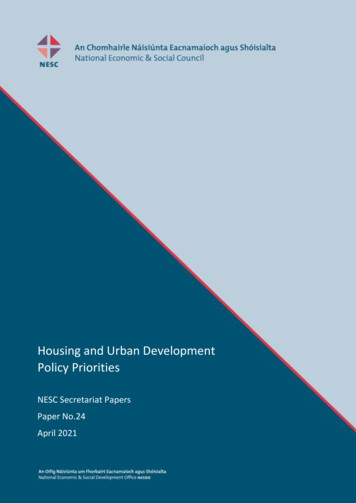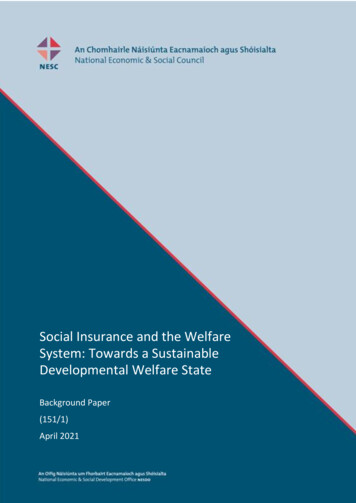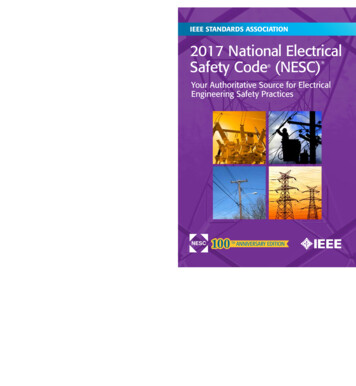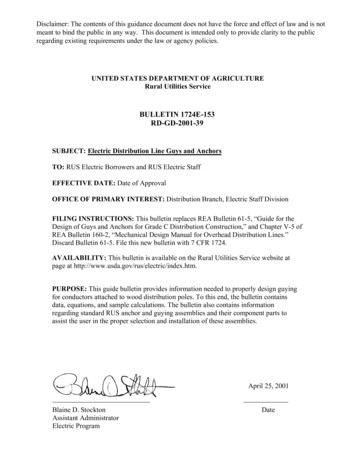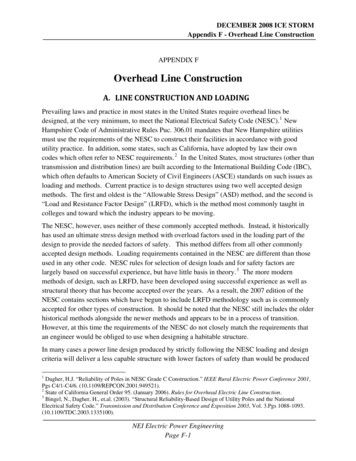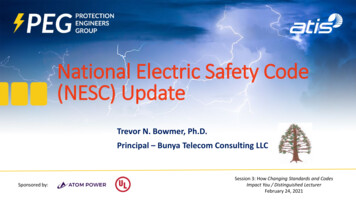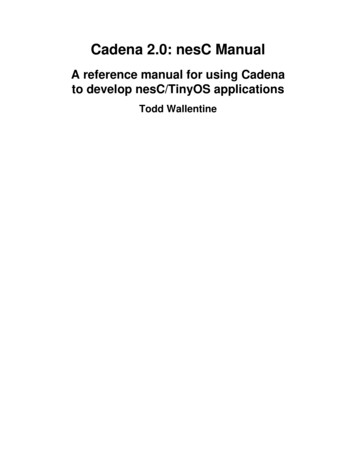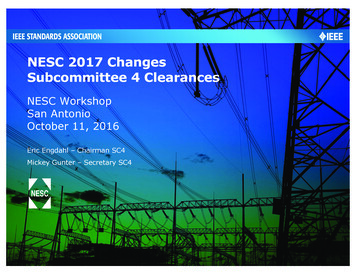
Transcription
NESC 2017 ChangesSubcommittee 4 ClearancesNESC WorkshopSan AntonioOctober 11, 2016Eric Engdahl – Chairman SC4Mickey Gunter – Secretary SC4
Sub-Committee 4SC4 Development of the NESC 2017¾310 Change Proposal Considered for the2017 NESC¾Addressed 199 Comments to the ChangeProposal¾130 Change Proposals Accepted by SC42
Change Proposals¾Many of the Accepted CPs Did NotChange the Intent of Code but ProvideConsistency Within Rules. Examples:– Lines and equipment with recorded conditions ordefects that would reasonably be expected toendanger human persons life or property shall bepromptly corrected, disconnected, or isolated.(CP4274)- Consistent with Rule 010– Clarified Where Grounding Requires Componentsto be Effectively Grounded (CP4299)- Continuation of effort started with 2012 Code.3
Change ProposalsUnqualified to UnauthorizedRule 217A2. Readily climbable supporting structuresa. Readily climbable supporting structures, such asclosely latticed poles, towers, or bridgeattachments, carrying open supply conductors,which are adjacent to roads, regularly traveledpedestrian thoroughfares, or places where personsfrequently gather (such as schools or publicplaygrounds), shall be equipped with barriers toinhibit climbing by unauthorized unqualifiedpersons or posted with appropriate safety signs.(CP4279)4
Antenna ClearancesRule 235I¾Existing Rule Correct– Scattered within the Code¾Makes Application of the Rules Difficultfor the User¾SC4 Consolidated All AntennaRequirements in Rule 235I (CP4346)5
Change Proposals Considered to be ofSignificance6
Guy Insulators¾15 Change Proposal Submitted on GuyInsulator Rules– Guy Insulators were also a revision topic for2012 Code¾SC4 Accepted Several CPs in Principleand Requested Public Comments¾28 Comments Were Received on theTopic of Guys and Guy Insulators.7
Guy Insulators¾There Are Several Issues:– Voltage Transfer If the Guy Wire Contacts AnEnergized Part To a portion of the guy wire within humancontact To communications facilities on the structure– Should the height above ground for the lowestportion of a guy insulator be increased from 8feet to 10 feet? Or to 14 feet?– Placing the Rules into a “practical” form whichcan be readily applied in the field8
Guy InsulatorsExisting Rules¾Rule 215C4a – 2012 NESC:– Insulator(s) shall be positioned so as to limit thelikelihood of any portion of an anchor guy, includingany conductive components of the insulator(s),becoming energized within 2.45 m (8ft) of the groundlevel in the event that the anchor guy becomes slack orbreaks below the lowest guy insulator.¾Rule 215C4b – 2012 NESC– Insulators shall be positioned so as to limit thelikelihood of any portion of an anchor guy becoming aconductive path between: (1) and energized conductoror rigid live part and (2) a conductor of another circuit,rigid live part, or equipment in event that anchor guybecomes slack or breaks below the lowest guyinsulator.9
Rule 215C4a2012 CodeEnergized linesor parts areaGuy InsulatorA Performance RuleGuy insulator shall be positionedsuch that no portion of the anchorguy, including any conductivecomponents of the guy insulator, canbecome energized within 8 ft of theground level when the anchor guybecomes slack or breaks below thelowest guy insulatorProvided by MickeyGunterAnchor Guy
Rule 215C4a2012 CodeEnergized linesor parts areaGuy InsulatorA Performance RuleGuy insulator shall be positionedsuch that no portion of the anchorguy, including any conductivecomponents of the guy insulator, canbecome energized within 8 ft of theground level when the anchor guybecomes slack or breaks below thelowest guy insulatorProvided byMickey GunterAnchor Guy
Energized linesor parts areaEnergized Anchor GuyTop of anchor guy above guyinsulator could be energized only 8’from the ground when the anchorguy becomes slack or breaks belowthe lowest guy insulatorProvided byMickey GunterRule 215C4a2012 Code
Change Proposal 4701 Accepted as ModifiedGuy Insulators¾Rule 215C2a for 2017 NESC RequiresAnchor Guys to be Effectively Grounded– Not a new Code requirement– The installation of guy insulators is anexception to the grounding rule¾Exception 2 to Rule 215C2a:– Guy insulators shall be positioned so as tolimit the likelihood of any portion of an anchorguy becoming energized within 2.45 m (8 ft)of the ground level in the event that theanchor guy becomes slack or breaks.13
2017 Major Changes to Guy Insulators¾Redefined How To Consider Clearances ifGuy Wire Were to BreakFrom: .in the event that the anchor guy becomesslack or breaks below the lowest guy insulator.TO:in the event that the anchor guy becomes slackor breaks.14
2017 Major Changes to Guy Insulators¾Removed the Specific RequirementRelated to Voltage Transfer on the GuyedStructure:– Insulators shall be positioned so as to limit thelikelihood of an anchor guy becoming a conductive pathbetween: (1) an energized conductor or rigid live partand (2) a conductor of another circuit, rigid part, orequipment in the event that the anchor guy becomesslack.¾SC Requested and Received Commentsfrom the Communication Industry– Voltage transfer concerns addressed by work rules andneed not be addressed in Rule 215.15
Guy Insulators¾SC4 Considered CPs Increasing thePosition of Guy Insulators from 8 feetAbove Grade to 10 and 14 feet.– Proposed increases were not accepted– SC4 Felt the Submitted Change ProposalsOffered Insufficient Justification No incidences where 8 feet was not sufficientwere presented 8 foot requirement goes back to the 3rd editionNESC16
Additional Guy Change Proposals¾Table 235-617
Additional Guy Change ProposalsTable 235-6¾Questions Surrounding Existing Table:– Application of “parallel to line”– Application of “anchor guys”– And what facilities are included in “all other”¾CP4715 Attempted to Address– Received 4 comments¾Comment 6277– Provided guidance as to application of“parallel”– Removed “all other”18
Additional Guy Change ProposalsTable 235-6¾Upon Additional Review, SC4 DeterminedCP4715 as Modified by the CommentsContained Unintended Consequences– There were differing interpretations bycompanies as how to apply the existing rules Thus, there was no consensus if the existingrules required revision– The proposed revisions required increaseclearances in specific applications How the existing rules were being interpreteddetermine whether these clearance increaseswere minor or significant19
Additional Guy Change ProposalsTable 235-6¾CP4715 was rejected by SC4¾No changes to rows 2a, 2b, or 2c¾SC4 Felt Table 235-6 Needs to beClarified– Discussions and received comments clearlyindicate that the application of the existingtable is not uniform.– Working Group Formed Review the clearances between energized parts anddown guys. Table 235-6 Row 2a, b, and c.20
Additional Guy Change Proposals¾217 C. Protection and marking of guys– Several Change Proposals and Comments– Issue focused on adequate guy wire markingin areas exposed to pedestrian traffic What is a pedestrian traffic area?– When multiple guy wires are involved How many must be marked?¾Added Note to 217C1(a):– NOTE: There is no intent to require markers at allanchor guy locations. (CP4453)21
Vegetation Management¾Two Change Proposals Considered– Expand existing rule to include vegetation thatmay damage communication facilities(CP4583)– Remove Note stating it is not practical toprevent all vegetation contact (CP4430)¾The Issues Revolved Around the SafetyAspects of Vegetation Management– Is contact with communication facilities a“safety issue”?– When vegetation “conditions” result in Codeviolations (clearances, loading, etc.)22
Vegetation Management¾SC4 Approved:Rule 218A. General1. Vegetation that may damage ungrounded supplyconductors should be pruned or removed. Vegetationmanagement should be performed around supply andcommunication lines as experience has shown to benecessary. Vegetation that may damage ungroundedsupply conductors should be pruned or removed.23
Relative Levels of Supply andCommunication LinesTwo Issues Considered¾Revised Rule 220B1 to State that SupplyConductors and Equipment Should beCarried at the Higher Level¾Rejected CP4597 CreatingCommunication Space and Worker ZoneAbove and Below Supply Space– Communication facilities in the supply spaceare “communication located in supply space”24
Table 232-1Service Drop Clearances over ResidentialDriveways and Yards¾16’ is the Basic Clearance Over a Driveway– Footnote 13 permits a reduction to 15’– Footnote 7 permits a reduction to 12’ Dependent on “height of the house”¾Footnote 7 was Revised to:Where the height of a residential building does not permit itsservice drop(s) to meet these values, Where vehicles exceeding8 ft in height are not normally encountered nor reasonablyanticipated, service drop(s) the clearances over residentialdriveways only may be reduced to the following:No Change in Clearances25
Table 232-1Service Drop Clearances over ResidentialDriveways and Yards¾Footnote 13 was Revised to:Where this construction crosses over or runs along (a)alleys, non-residential driveways, or parking lots notsubject to truck traffic, or (b) residential driveways, thisclearance may be reduced to 15 ft.¾These Revisions to Table 232-1– Removed the house height as the factor forreduced clearances– Made the land use under the service drop, thevehicle height the factor to consider whenreducing the clearances.26
Street Light Brackets¾Revised Table 238-2 to Require 40”Clearance Between an UngroundedStreet Light Bracket and CommunicationFacilities Within the CommunicationSpace (CP4139).– Currently, 20” required Not considered adequate if the streetlight bracket were to become energized– Clearance can be reduced to 4” if streetlight bracket grounded.27
Working Group ReportsWGs Established at October, 2013 SC4Meeting¾Working Groups Were Assigned toProvide SC4 Direction on Specific ChangeProposals– WG 4.1 (CP 4683) Determine if a new extreme ice loading criteria isrequired for road crossings– WG 4.2 (CP4468) Determine if the Code needs to developclearances to agricultural irrigation systems andwater streams28
Working Group 4.1Extreme Ice Loading¾Three Comments to the Change Proposal4683 Considered by the WG– SC4 requested additional information fromcommenters– No specific documented cases were providedwhere the existing NESC road clearances wereinsufficient29
Working Group 4.1Extreme Ice Loading¾WG 4.10 Previously Reviewed PossibleClearance Increases Based on Rule 250DIce Loadings– Found the existing method to determineclearances is credible Based upon a safety record of some 70 years¾WG Conclusion: No Change to SC4’sAction to Reject CP4683– Extreme ice loading conditions for roadclearances not required30
Working Group 4.2Clearances to Agricultural IrrigationSystems¾Three Comments to CP4468 WhereConsidered by the Working Group– Two comments supported the need forthe NESC to provide specific clearancerules but offered no suggestions orinsight has how to frame the clearances– The third commenter felt the NESCcurrently contained sufficient guidancefor a Code user to provide adequateclearances31
Working Group 4.2Clearances to Agricultural IrrigationSystems¾The Working Group Did Not HaveAdequate Time to Draft and Finalize aWritten Report to SC4– Verbal report supported the positionthat the Code currently containedadequate rules for a Code user toprovide clearances to large irrigationsystems¾The Working Group Elected to Continue– Provide a written report to SC432
Questions?33
- Insulator(s) shall be positioned so as to limit the likelihood of any portion of an anchor guy, including any conductive components of the insulator(s), becoming energized within 2.45 m (8ft) of the ground level in the event that the anchor guy becomes slack or breaks below the lowest guy insulator. ¾Rule 215C4b - 2012 NESC
